By Matt Wastradowski
When my girlfriend and I booked a vacation to see the aurora borealis in Alaska, we figured we’d enjoy dazzling displays every night. We’d booked our trip for mid-March—one of the best times of year to see the northern lights. As long as forecasts were favorable, I assumed the sky would pop with dancing waves of brilliant green, purple and pink light every night. On our flight’s descent into Anchorage, outside our cabin near Fairbanks, basically, whenever the sun went down, we’d see the famous northern lights.
Yet, there we were on our first night in Fairbanks, anxiously awaiting the show to begin from inside Aurora Pointe. My girlfriend and I joined a few dozen travelers at the cozy hilltop viewing shelter, where the plan was to stay warm inside while waiting for the lights to appear outside. I was so sure of the aurora’s imminent arrival, I briefly considered leaving my parka on so I could sprint outside as soon as the first flicker of light appeared above the horizon.
As we settled in, pouring coffee at the self-serve station to steel ourselves for a long night of viewing, a knowledgeable speaker debriefed us on the aurora—what it is, how it happens and why a display was unlikely that night. The starry night skies, he informed us, would most likely remain just that.
This bad news—and my own ignorance—took me by surprise. What do you mean the aurora won’t come out tonight? Doesn’t it come out whenever the skies are clear?
As it turns out: No. The aurora does not, in fact, appear whenever the skies are clear. As I learned that evening, a clear sky is just one of many factors that have to line up for the natural phenomenon to make an appearance, most importantly, the location of the ever-moving aurora oval. Even if conditions are right, there’s no guarantee a display of the kind captivating humankind since time immemorial will materialize on any given night.
So there I sat for four hours, anxiously watching a webcam livestream that showed nearby night skies in between games of Uno with my far more patient girlfriend. Every so often, I’d stretch my legs with a quick walk outside, peering into the darkness and wishing for even the slightest glimpse. Occasionally, I’d check my phone to see if this reading or that measurement had changed since I last looked five minutes ago. But at 2 a.m., with Aurora Pointe closing for the night, my girlfriend and I threw on our parkas, walked to our car, and reminded each other that we still had several more days in Alaska.
Alas, the northern lights never materialized on our trip. I can’t paint a dramatic picture of what it’s like to stand under the soul-stirring aurora borealis. Still, I can offer a few tips for giving yourself the best chance to see the natural phenomenon, and recommendations for where to enjoy the rest of your time in Anchorage and Fairbanks, the state’s most popular aurora destinations.
Aurora Borealis 101
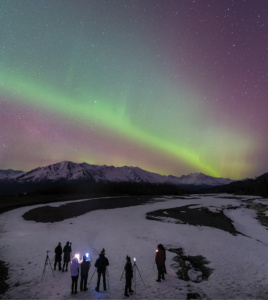
Photo courtesy of Alaska Photo Treks, Carl Johnson
What is the aurora, anyway? According to Don Hampton, research associate professor with the Geophysical Institute at the University of Alaska Fairbanks, the aurora borealis begins when particles from the sun enter the Earth’s atmosphere. As soon as that happens, our planet’s magnetic field directs those particles to Earth’s north and south magnetic poles—where the sun’s particles collide with oxygen and nitrogen in our planet’s atmosphere, gaining energy. Ultimately, the particles release that energy as light—creating the dazzling effects of the aurora borealis in the north. Aurora displays can be more or less vibrant due to a number of factors: how fast the solar wind arrives in our atmosphere, the density of those particles and so forth.
More or less, “aurora season” is whenever it’s dark enough at night to see the lights. The best viewing months are typically September, October and March, while cloudy skies render December and January some of the worst viewing months. Then on a given night, Hampton says the dramatic green lights are most active between 1:30 a.m. and 3 a.m.—so dress warm.
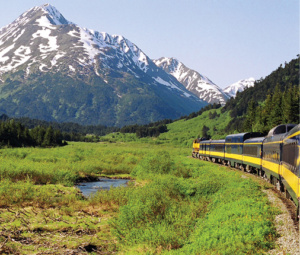
The Alaska Railroad is outfitted with transparent ceilings to allow on-board aurora viewing. Photo Credit: iStock, Sherry Epley.
Much of Alaska, including Fairbanks, sits under what’s called the aurora oval—a halo around the geomagnetic poles, always expanding and contracting—that essentially determines whether you might see a display.
You’ll likely fly into Anchorage or Fairbanks and make one of those cities your base camp for viewing. If you’d like to split your time between the cities, expect an eight-hour drive each way along the George Parks Highway. If you have time, consider traveling between Anchorage and Fairbanks aboard the famed Alaska Railroad; trains run all winter long, are outfitted with transparent ceilings and are scheduled to allow for on-board aurora viewing.
Mother Nature runs the show so plan your vacation for when it’s most convenient, not necessarily when you think the northern lights might appear. Carl Johnson, owner of the Alaska Photo Treks tour company in Anchorage, said that he enjoyed visible displays every night he took a group out in December 2021, while he struck out multiple times the following March, when conditions are usually optimal.
A few resources can help you plan a successful viewing experience. The Geophysical Institute at the University of Alaska Fairbanks runs an aurora forecast website that shows the location of the aurora oval, activity levels and predictions for up to twenty-seven days. Explore Fairbanks, the city’s destination marketing organization, offers a real-time tracker that covers conditions at various viewpoints, forecasts and more.
Planning an Anchorage Trip to See the Aurora
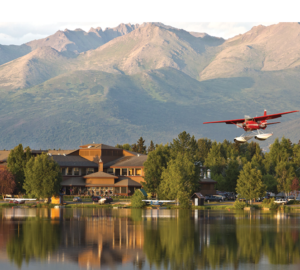
The Lakefront Anchorage deck provides views of float planes landing on Lake Spenard. Courtesy of the Lakeside Anchorage.
The state’s largest city sits along Cook Inlet and at the foot of the Chugach Mountains. A handful of tour companies offer outings around Anchorage when conditions are right. Johnson’s Alaska Photo Tours company, for instance, may visit up to three locations on a given tour, with each destination chosen on the fly to account for photo-worthy backdrops and the intensity of that night’s display. If it’s a clear night with little wind and an especially bright display, for instance, Johnson might take visitors to a viewpoint along Cook Inlet for scenic reflective shots.
Our scheduled outing with Johnson was sidelined by cloud cover, but we found plenty to love about the city. Here are a few ideas for making the most of your time in town while not watching the skies.
STAY: The Lakefront Anchorage sits on the shore of Lake Spenard; it offers quick access to Point Woronzof Overlook, where wide-open views to the north afford excellent viewing opportunities, and the Glen Alps Trailhead and Viewpoint in Chugach State Park (one of the most popular viewing spots around Anchorage).
PLAY: The Anchorage Museum hosts four floors stuffed with fascinating exhibits on Alaska’s industrial past, Indigenous communities and more. If you’re looking to get outdoors, hit the 11-mile Tony Knowles Coastal Trail, which runs along the Cook Inlet; fat tire e-bike rentals are available from Pablo’s Bicycle Rentals in downtown, a short ride to the trailhead.

Lunch at the Snow City Cafe includes classics served with an Alaskan twist. Photo courtesy of the Snow City Cafe.
EAT: Snow City Cafe is a popular brunch and lunch spot when you need a pick-me-up after a late night of aurora chasing. The busy diner serves breakfast classics with an Alaskan twist, like smoked salmon cakes and benedicts made with fresh snow crab.
Planning a Fairbanks Trip to See the Aurora
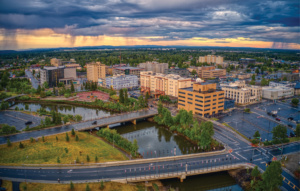 Fairbanks may be the land of the midnight sun in summer, but come winter, it’s the aurora capital of Alaska. Socked away in Alaska’s interior, Fairbanks enjoys a mix of clear nights and close proximity to the aurora oval, both factors that make it a go-to destination to see the aurora.
Fairbanks may be the land of the midnight sun in summer, but come winter, it’s the aurora capital of Alaska. Socked away in Alaska’s interior, Fairbanks enjoys a mix of clear nights and close proximity to the aurora oval, both factors that make it a go-to destination to see the aurora.
Naturally, a variety of outfitters and outposts work to help visitors see the natural phenomenon. For instance, the Alaskan-owned-and-operated Salmon Berry Travel & Tours offers guided tours between December and March; each includes a breakdown of the science behind the northern lights and their importance to Indigenous Alaska Native peoples. Stories vary among Indigenous groups, but many view the lights as the spirits of the dead or spirits of the animals they hunted. Of course, visitors who’d rather skip a guided outing can purchase tickets to Aurora Pointe, just 20 minutes northeast of Fairbanks, where they can keep warm inside a heated hut while waiting for the lights to appear.
Even though sunny skies and clear nights didn’t translate into electric aurora displays, we threw ourselves into Fairbanks’ many attractions. If you’re looking to stay busy during the day, here’s how to enjoy your time around Fairbanks.
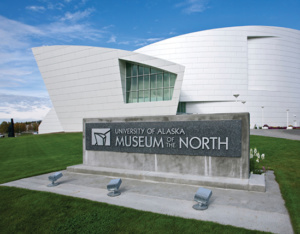
Photo courtesy of Alamy.com/Pep Roig
STAY: Most local hotels will call your room if the northern lights appear, while some cater specifically to aurora chasers: Aurora Borealis Lodge, open between mid-August and mid-April, offers four private rooms with north-facing windows (for the best views) and a log home with a 15-foot-tall viewing platform in the front yard.
PLAY: The Museum of the North at the University of Alaska Fairbanks goes in-depth on the state’s biggest ecological regions through interpretive panels, animal displays and more.
EAT: Around town, you’ll find more than a dozen Thai restaurants, including a few drive-thru spots. Fairbanks’ love affair with Thai food began in 1989 with Thai House Restaurant, which remains a community stalwart three decades later. Make sure to catch a bite when waiting to see a glimpse of the aurora.
Pack Your Bags for Alaska With Help From AAA
Download the AAA Mobile app for maps, discounts, restaurants, and lodging at AAA.com/mobile. For help planning your trip, find a local AAA Travel Agent or call AAA Travel at 800-529-3222.


